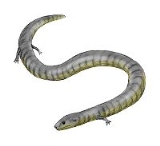
Eocaecilia
Encyclopedia
Eocaecilia micropodia is an extinct species of caecilian
(limbless amphibian) from the Early Jurassic Period in Arizona
, USA. It shared some characteristics with salamander
s and the now extinct Microsauria
. Unlike modern caecilians, which are legless, Eocaecilia possessed small legs, and while modern caecilians have poorly developed eye
s and spend a lot of time under ground, Eocaecilias eyes were still well-developed, indicating it was not subterranean.
Caecilian
The caecilians are an order of amphibians that superficially resemble earthworms or snakes. They mostly live hidden in the ground, making them the least familiar order of amphibians. All extant caecilians and their closest fossil relatives are grouped as the clade Apoda. They are mostly...
(limbless amphibian) from the Early Jurassic Period in Arizona
Arizona
Arizona ; is a state located in the southwestern region of the United States. It is also part of the western United States and the mountain west. The capital and largest city is Phoenix...
, USA. It shared some characteristics with salamander
Salamander
Salamander is a common name of approximately 500 species of amphibians. They are typically characterized by a superficially lizard-like appearance, with their slender bodies, short noses, and long tails. All known fossils and extinct species fall under the order Caudata, while sometimes the extant...
s and the now extinct Microsauria
Microsauria
Microsauria is an extinct order of lepospondyl amphibians from the late Carboniferous and early Permian periods. It is the most diverse and species-rich group of lepospondyls. Recently, Microsauria has been considered paraphyletic, as several other non-microsaur lepospondyl groups such as...
. Unlike modern caecilians, which are legless, Eocaecilia possessed small legs, and while modern caecilians have poorly developed eye
Eye
Eyes are organs that detect light and convert it into electro-chemical impulses in neurons. The simplest photoreceptors in conscious vision connect light to movement...
s and spend a lot of time under ground, Eocaecilias eyes were still well-developed, indicating it was not subterranean.

